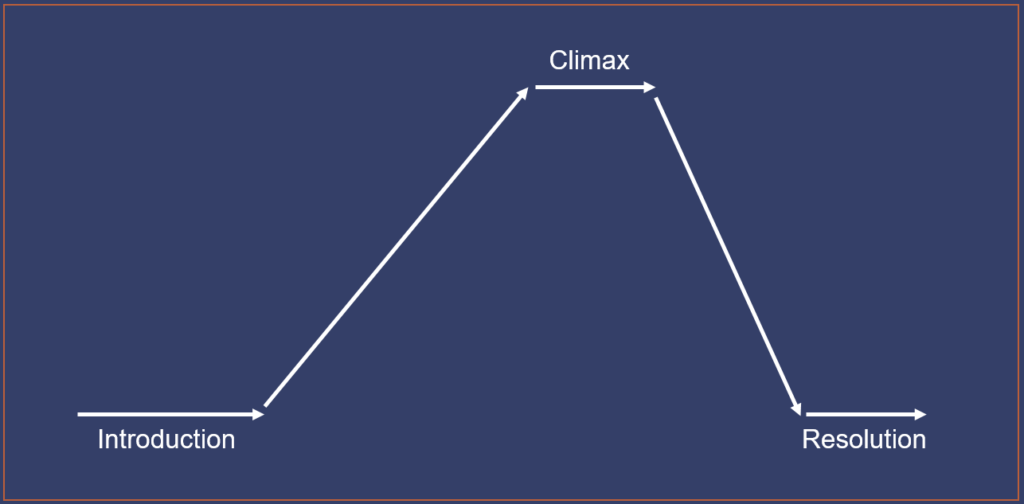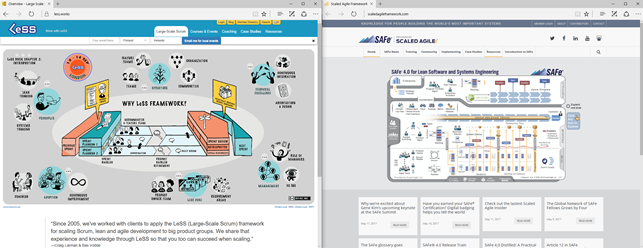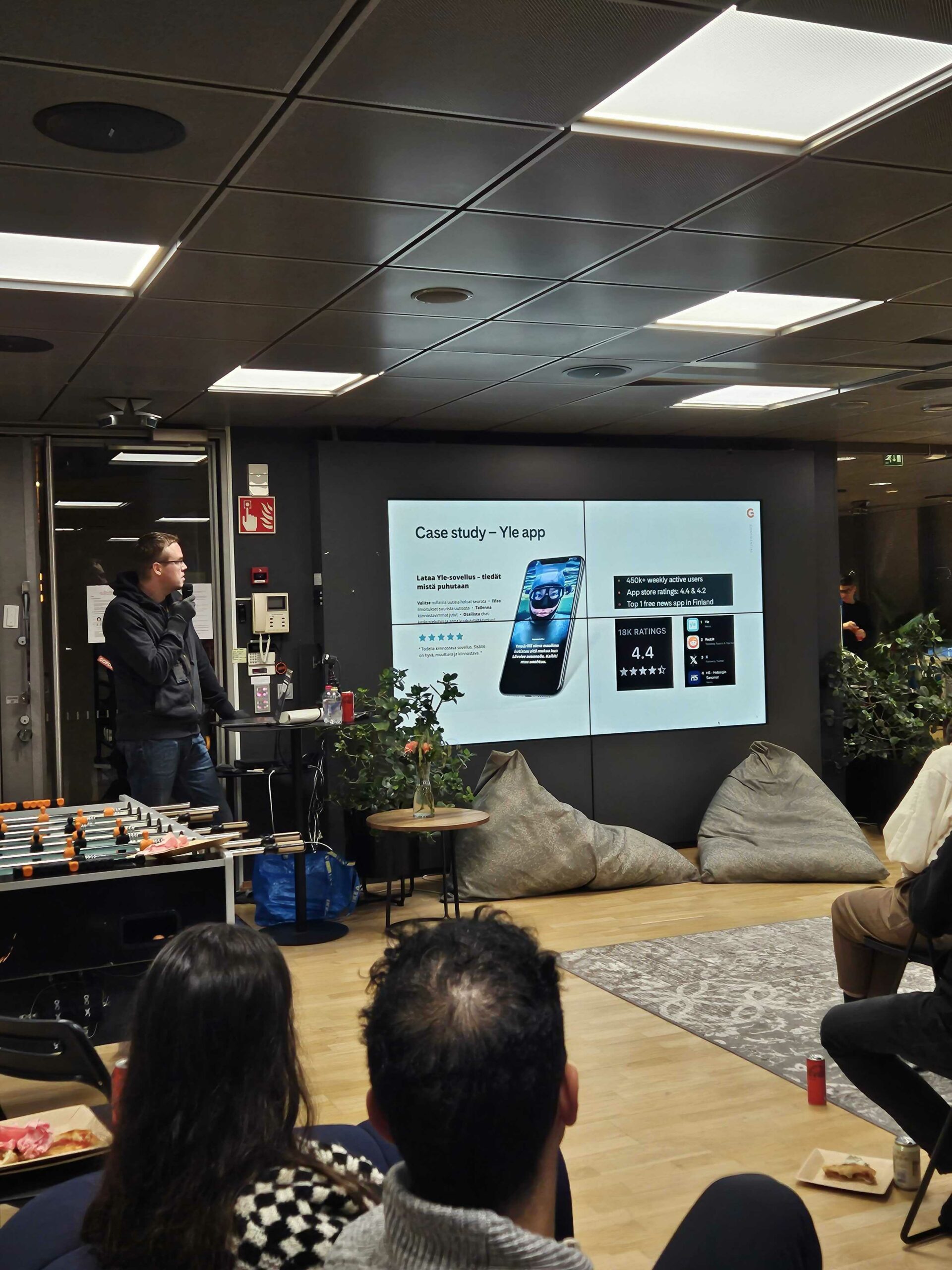First of all. Ahoy, all you “Why agile” and “I don’t need scaling, I already have Scrum” people. Please start here.
I’ve followed the growing interest towards methods of scaling agile for the last decade. Personally I faced the idea of scaling Agile, whilst working as a subcontractor for Nokia. Back then two very different kind of frameworks were born. Ari and Ran explains the history of these scaling frameworks, so I won’t go there. I’ll just want to find out, which approach is better. The fastest and most entertaining way is to take our two of the most experienced scaling agile gun men Stefan and Juhana and start shooting. Whilst the gun men are warming up, let’s make a quick generic comparison of the frameworks.
We’ve blogged earlier about SAFe (in Finnish) and LeSS in rather positive tone – now it’s time to get some friction between them. Like in all the unforgettable shootouts, the tension must be built gradually from introduction and rising action towards climax.
Name
I must say, if I created a scaling framework, I wouldn’t name it either “Safe” or “Less”. The “Less HUGE” makes things even more paradoxal.
There is a clear winner on the field of naming the Scaling Agile framework. The Recipes for Agile Governance in the Enterprise aka “RAGE” wins the fight between names.
Portal
Never, ever design usability restricting cr*p on any media in the name of copyrights. It is a lose-lose deal.
- The hippie drawing style of LeSS will make all the wave riding, new age developers feel warm and fuzzy.
- The engineering style, mind-blowing-in-details drawings of SAFe will make all the managers feel super important. However, the copy-paste restriction of SAFe portal sucks, while it also disables for example text search of browser.
LeSS wins the fight between the portals.
Book
We live in a colorful world. Use them.
- Both books are the same diameter and around 330 pages.
- Both books come from Addison-Wesley.
- SAFe book has more pictures and colors, otherwise they are rather similar.
SAFe wins the fight between books with flying colors.
Introduction of The Gun Men
Question #1: Tell us a little bit about yourself and when you became a fan of SaFE / LeSS?
Stefan:
I’m a business manager and consultant at Gofore. Currently I’m focusing on our customers in health technology, healthcare, social care and wellbeing businesses. Throughout my professional career I’ve been interested in all development methods – from SW development to business & customer development. I was first exposed to SAFe whilst working at Nokia a decade ago, but the real revelation of SAFe to me happened at GE Healthcare in 2014. We had 16 teams, nearly 200 professionals scattered across globe with a goal to create multiple new products together. We applied SAFe to align the goals, sync on delivery and to optimize flows.
Juhana:
I’m a lead consultant of software development at Gofore. I have a background in software engineering and have been in the IT field for more than decade. I’ve taken part for some of the biggest public sector digitalization endeavours in Finland. For some reason, I’ve always been the guy who’s removing obstacles and trying to improve everything. So, the Scrum Master’s duty was a natural choice for me. Lately, I’ve focussed on transforming entire organisations to Agile mode. In the latest project, I was consulting a large software program that required Agile transformation. I needed a powerful and straightforward solution for the transformation. The LeSS approach caught my attention very quickly; the LeSS principles and rules were understandable and simple. The challenges confronted in the target organization were tackled intelligently with the LeSS method. This would not have been possible if using a one-size-fits-all format such as the SaFE.
Conclusion:
SAFe interest people in management type of roles and LeSS fascinates adventurous problem solvers.
Rising Action
Question #2: Imagine a 40 person project working in waterfall model. How would you deploy SAFe/LeSS?
Educate everyone into Agile mindset
Stefan:
SAFe provides the best practices from industry also for the deployment of SAFe. The things to conside in deployment are:
- Train everyone: a) train the leaders, b) train the internal change agents, and c) train project personnel.
- Split project to 2-pizzas-serves-them teams. Select team level development methodology, e.g. Scrum. Make sure that teams have the right set of competences to work as feature teams.
- Define the way of working for the organization. For a 40 person program the two lowest level of SAFe framework serve the purpose: 1) Team level and 2) Program level.
- Then it’s about start your Agile Release Train to develop in common cadence according to commonly agreed increment plan. The increment planning and demo sessions are where the magic happens – the whole program planning, resolving and agreeing together in the same room and at the same time.
Juhana:
The LeSS creator Craig Larman’s advice for large, multi-site, and/or offshore programs is just ‘don’t do that’. Instead pick the ten best developers. If you must scale, here are the adaption principles:
- You should educate everybody. The easiest way is to sign people to the Scrum and LeSS trainings. The formal coaching is followed up by a team, organisational and technical coaching.
- Define the product as broadly as possible. A broader definition tends to be more customer centric and creates simpler organisations.
- Define the ‘DoD (Definition of Done)’. A better and stronger DoD eliminates groups, roles, and positions.
- Have appropriately-structured teams. One team member belongs to only one team, and the teams are stable, long-lived, cross-functional, and co-located. Only the Product Owner provides work for the teams. Keep managers away from the teams.
Conclusion:
Both approaches aim to educate and engage everyone.
Climax
Question #3: Our current organisation has 3 team leaders, 1 architect, 1 project manager, 1 product manager and 1 UX/AD specialist. What would these persons do in SAFe/LeSS?
Stefan:
When using Scrum on team level then there are roles of the Scrum Master, Product Owner and SW developers. On program level you’ll find Product Management and Business Owners. Note, that the role of leaders in SAFe is different from traditional management – the roles are Lean-Agile leadership type of roles.
- The old team leaders from the legacy organization could become developers, Scrum Masters or Product Owners depending on their capabilities and desires.
- Architect and UX/AD specialist could continue working across the teams in program level roles.
- Project manager could be promoted to the role of Release Train Engineer.
- Product Manager could continue with same title, but in a modified role at product management.
Juhana:
Specialised roles are forbidden in LeSS.
- The team leaders can become Scrum Masters. They should follow the servant-leadership-mindset such as putting people first, coaching, removing obstacles, and creating the community. One Scrum Master can serve one to three teams.
- The Architect and UX Designer will each join a team. In addition, the architect can lead or be part of the architect community, and the UX Designer can lead or be part of the user experience community. The communities ensure the cross-cutting quality and are run by the team members.
- the product Manager can take the Product Owner’s role and responsibilities.
- The project Manager could focus on increasing the capability of the organisation’s value delivery with using techniques such as ‘Go and See’ and ‘See the Whole’. The Product Manager role is also temporarily needed if there is a weak Definition of Done.
Conclusion:
Tune-down way of SAFe makes it easy to sell towards legacy management. SAFe has built-in program management process and roles. Build-up way of LeSS asks “How to simplify the organization, and be agile?”.
Question #4: Okay, now the program is working according to SAFe/LeSS framework. How does the model scale when you add two more teams?
Stefan:
SAFe’s program level guidelines make this rather easy. Assuming the teams are feature teams then it’s rather easy to add new teams – just invite them to the common Release Train Planning event and share the prioritized increment backlog across the teams. SAFe can scale up to multiple release trains and multiple value streams, but at that extreme we would be then talking about thousands of developers, and that’s a bit scary anyway.
Juhana:
LeSS scales easily – you just add two more teams to the structure. Avoid creating component-based teams such as front-end, integration, or operation teams. If the number of teams exceeds eight, use the LeSS Huge framework. It’s based on the same principles and rules, but adds a few extra practices.
Conclusion:
After reaching Lean Agile organization scaling is easy.
Resolution
Both models require the Enterprise to change. Agile is about mind-set, not about roles or processes.
It seems that the path for agile scaling is rather similar, no matter what framework you are using. After the first hour of shooting, there is yet no clear winner.
Thanks for reading! Please, throw in any additional questions!
We will tackle those in the Shootout Sequel, where we will finally find out, which one of these two frameworks is the best.






